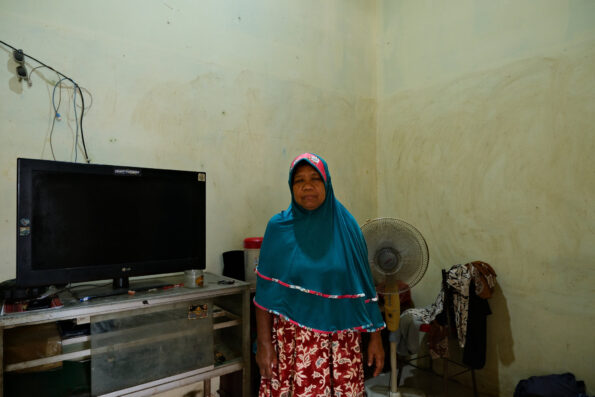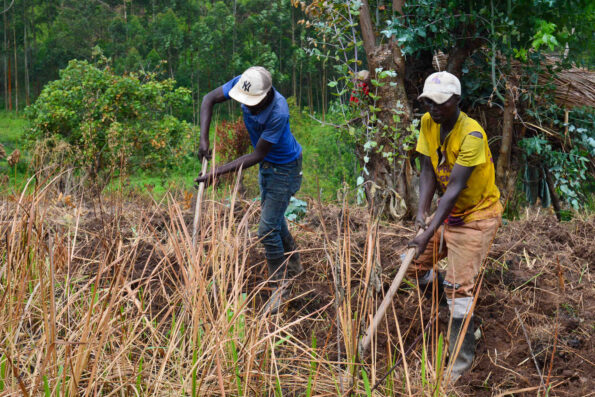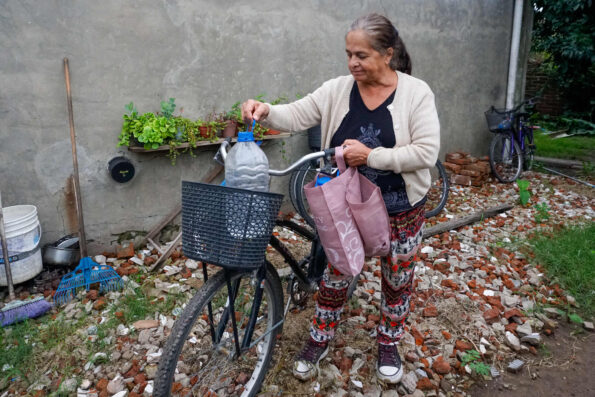
EDNA NAMARA, GPJ UGANDA
A truck with tightly packed cattle arrives at the unloading yard of Kampala City Abattoir. Animal rights advocates want the government to enforce laws that require humane treatment of animals during transportation.
KAMPALA, UGANDA — As soon as the truck pulls up, Joseph Lubwama jumps out and starts unloading 24 tightly packed cattle he has brought to Kampala City Abattoir. He begins by untangling a web of ropes used to tie the cattle’s long horns to the rails of the truck bed to keep them still. They have been on a 250-kilometer (155-mile) journey from Kiruhura, a rural district in southern Uganda. One by one, the cattle step out of the truck. They look tired.
“For the animals to travel that long tied to one position by the horns and tail, it is uncomfortable,” says Lubwama, as he begins to herd them off the truck.
What seemed like genuine concern vanishes when Gaju, a bull with the majestic horns typical of the Ankole breed, wobbles, falls in the middle of the truck bed and can’t get up.
“Get up, Gaju! Go, go, go, Gaju, go,” Lubwama shouts as he kicks the animal and mercilessly strikes it with a cane.
When Gaju doesn’t budge, Lubwama finds support on the frames of the truck’s cargo cage and kicks the animal hard using both legs with his heavy gumboots. The apparent pain forces Gaju to gather strength, stand up and stagger out of the truck.
Kampala’s steady population growth over the last three decades has created high demand for beef. But the city doesn’t permit raising cattle within its limits, meaning that people like Lubwama have to bring in cattle from ranches hundreds of kilometers from the city’s abattoirs. But the inhumane way cattle are transported has led to a debate between animal rights activists and veterinarians who are calling for government intervention, and cattle dealers who contend that they would lose money if the current laws were enforced.
Since 1992, the capital city has averaged an annual population growth rate of at least 5%, raising the number of residents from around 830,000 to more than 3.6 million in 2022, according to data from the United Nations World Urbanization Prospects. The average Ugandan consumes about 9 kilograms (20 pounds) of beef a year, with Kampala district accounting for the largest portion, 7% of the country’s annual production of 185,709 metric tons, according to a report by the Food and Agriculture Organization of the United Nations.



David Kakooza, a veterinarian’s assistant who keeps records of the overcrowded trucks of cattle arriving daily at the abattoir, says he doesn’t feel good seeing animals arrive so fatigued. He wishes the government could enforce existing laws and regulations that are supposed to ensure animals are not tortured during transportation.
“Animals have rights, too,” Kakooza says as he inspects a truck carrying 21 head of cattle.
Standing orders of the Uganda National Bureau of Standards stipulate that trucks “shall have enough space for the comfort of slaughter animals during transit, cattle placed crosswise on a lorry shall allow 50 cm to 60 cm of the truck length for each animal.” Transportation of animals for slaughter “shall be carried out in a way that minimizes stress, pain and suffering,” according to the guidelines. There is also the Animals (Prevention of Cruelty) Act, which states that any person who “cruelly beats, kicks, ill-treats, overrides, overdrives, overloads, tortures or infuriates any animal” is guilty of the crime of cruelty.
Siraj Katangawuzi, the imam of Nansana parish, says he wants to see these laws and regulations strictly enforced to ensure that animals are transported without suffering. He says one simple change the government could make is to require the use of timber instead of ropes to prevent cattle from falling during transportation. The government should also educate Ugandans on the importance of being kind to animals and revoke the licenses of those who refuse to follow the law.
“Ugandans need to realize that everything that breathes has feelings,” Katangawuzi says. “It is impossible for humans to travel all that distance without changing position, but cows, too, have feelings, so they should not be tied so mercilessly.”



Dr. Dickson Tayebwa, an animal welfare advocate and veterinarian who lectures at Makerere University, says existing laws are not enforced because “big men” — powerful government officials who own extensive cattle ranches and many of the trucks that transport animals to Kampala’s abattoirs — dominate the meat industry.
“Their trucks have papers indicating that they are special,” Tayebwa says. “So, the officers manning roadblocks cannot say anything, even when it’s clear that laws are being broken.”
An officer at the Ministry of Agriculture, Animal Industry and Fisheries, who wants to remain anonymous for fear of retaliation, acknowledges that the presence of powerful people in the industry makes government regulation difficult.
“They are untouchable,” the officer says.
David Kasura Kyomukama, the permanent secretary at the ministry, says he cannot comment on the issue of top government officials impeding the enforcement of laws. But he says the ministry is trying to convince people in the industry that obeying the laws and regulations would be in their best interest.
“Animals are animals, so they can’t be treated like people, but they can be treated well on the journey so that we get money out of them,” Kyomukama says. “If you treat animals in a way that stresses them, you won’t get their full worth, as some might lose weight, or even die.”
Kyomukama says the ministry plans to set up abattoirs in regions across the country so that animals are slaughtered closer to where they are raised and their meat transported to Kampala and other urban centers. He doesn’t say when that might happen.
Dr. Hannington Katumba, a Kampala city council veterinarian, agrees that treating cattle well would benefit the beef industry and consumers because healthy cows produce high-quality meat. He explains that when a cow is reacting to high levels of stress, its body excretes lactic acid, which increases acidity and makes meat fail to settle.
“That is the ugly meat we sometimes see in stalls. It looks beaten,” Katumba says.
The fact that Ugandan culture doesn’t generally value animal welfare has made ending cruelty against animals more difficult. Samuel Bwanakweri, a herder from western Uganda who has been in cattle trade and transportation for 21 years, laughs when asked why animals are treated so cruelly during transportation to the abattoirs.
“What is all the fuss about? They are heading to the slaughterhouse,” he says matter-of-factly. “Isn’t it ironic to feel pity for an animal you are going to kill?”

Animal Afflictions
Disease outbreaks not only threaten wildlife, they also upend livelihoods and devastate the environment.
read hereBwanakweri says that he spends a lot of money to transport the cattle from as far away as 320 kilometers (almost 200 miles) to the abattoirs and that following the regulations would not make economic sense. To break even, he says he needs to get 23 cows on each truck because he must hire four handlers at 100,000 Ugandan shillings ($26) each. He also pays the truck owner and the bank that gives him business loans.
Although he’s not as dismissive as Bwanakweri about animal welfare, Bonny Katambula, a committee member of Kampala City Abattoir, agrees that if the current laws and regulations were to be strictly enforced, many dealers would be out of business. He says the ideal number for the large trucks should be 20 cows.
“A man cannot hire a truck for 1 million shillings [$260], drive it upcountry for cattle and return with only 10 cows,” he says. “That defeats the economic purpose.”
Lubwama says his goal is to work his way up in the beef industry. As a cattle handler, he earns 100,000 shillings ($26) for each of the three trips he makes weekly. He is working hard to save money and be able to have one of his own cows on the truck.
“My dream is to slowly build my business and be able to fill a truck with my cattle,” he says as he leads Gaju and several cows to the yard for fodder, water and rest.
After 12 hours, he will herd Gaju to the slaughterhouse, where the bull’s journey will end. The meat will be processed, and the health inspector will stamp it to certify that it has been checked for disease and deemed healthy for human consumption. Lubwama will head back to Kiruhura and load the truck with more cattle for his next trip to Kampala to help quell the city’s hunger for beef.
Edna Namara is a Global Press Journal reporter based in Kampala, Uganda.







